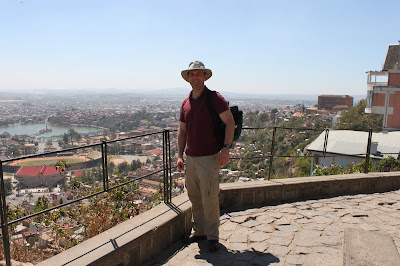 |
| Standing where Hochburg stands |
TANA – or to give it its
full name Antananarivo (literally: the city of a thousand warriors) – is the
capital of Madagascar. It’s a long journey there: London to Paris for the
connecting flight, then eleven hours down and across Africa to the Indian Ocean
and southern hemisphere. Arriving was not for the faint-hearted. The plane landed
at what looked like an abandoned airport. Along with four hundred fellow
passengers I had to hurry across the tarmac into a suffocatingly humid arrivals
hall. There were no queues, just an interminable scrum to get through.
Immigration documents had to be filled out by hand, in triplicate, and
presented to two different desks in order to get my passport stamped. The diary
I kept while travelling simply reads, ‘ABSOLUTE CHAOS’. However, no matter how
wearing it was (the heat, the press of bodies, screaming babies, an hour to get
to the front), it occurred to me that it would have been nothing compared to the
bedlam millions of Jews would have faced arriving in Nazi Madagaskar.
Next morning I began my
exploration of Tana proper. I was staying in the suburbs and to get to the
centre had to drive past shanty towns and brick factories, paddy fields, and canal
banks with literally miles of washing laid out to dry on them. Tana reminded me
of many big Africa cities: overcrowded, chaotic and slightly shabby, a
bricolage of colonial architecture and more recent concrete blocks. It was also
full of colour and a vibrancy that cities in the developed world just don’t possess.
The lower town is truly labyrinthine, navigation around it made all the harder
by the fact many streets don’t have names or that the names change regularly
depending on which dictator is in power.
My most vivid memory is the
main marketplace, especially the butchers where sausages and great racks of
zebu rib (the local cattle) hung beneath red canopies, dripping blood and buzzing
with flies. There was no sign of any refrigeration. I’ll leave the smell to
your imagination.
Tana is built on a twelve
hills, the highest of which is crowned with Queen Ranavalona I’s palace. Erected
in the mid-19th century, it was destroyed by fire in 1995, leaving just the
stone shell and has been in a state of permanent renovation since. From here I
had a spectacular view across the plains as they shimmered in a heat haze. A
warm breezed licked my face... just the way it does when Hochburg stands in the
same spot in Chapter 16. The palace was the model for Globus’s headquarters in
the book, not least because its rocky foundations are steeped in blood.
Ranavalona, known as ‘the wicked queen’, was notorious for hurling those who
displeased her off the walls of her palace. It seemed an appropriate base for
the SS.
T is also for TAFT
 [Spoiler alert.] One of the
arcs that runs through the trilogy is America’s involvement in Africa: from disengagement
in Afrika Reich through to being a
full player in Book 3. America’s role in the world order is a key part of the
plot in Madagaskar. For this I needed
a president who was isolationist but not slavish so, as well as one with an
ambiguous attitude to the fate of the Jews. At first I thought of making up a
character, but given that most of the historical figures in the book are real,
I felt obliged to do the same with my president. So I started scouring all
presidential candidates and hopefuls of the 1940s and early 50s.
[Spoiler alert.] One of the
arcs that runs through the trilogy is America’s involvement in Africa: from disengagement
in Afrika Reich through to being a
full player in Book 3. America’s role in the world order is a key part of the
plot in Madagaskar. For this I needed
a president who was isolationist but not slavish so, as well as one with an
ambiguous attitude to the fate of the Jews. At first I thought of making up a
character, but given that most of the historical figures in the book are real,
I felt obliged to do the same with my president. So I started scouring all
presidential candidates and hopefuls of the 1940s and early 50s.
The biggest difficulty with
this was how real history affected my choices. For example, Eisenhower became
president partly on a war-hero ticket; other candidates were popular because
they were tough on Communism, a stance that makes little sense in my world. I
therefore had to disentangle these elements from my selection. Luckily, one
figure soon came to the fore: Robert A. TAFT, a senator from Ohio and son of William
Taft, the 27th President.
Taft had narrowly missed
securing the Republican Party’s nomination for president against Eisenhower in
1952, so was a highly credible possibility given my altered timeline. Taft had
another advantage. He died in July 1953 – i.e. three months after the events of
Madagaskar – so if the narrative for
Book 3 changes I have an excuse to ditch him!

No comments:
Post a Comment